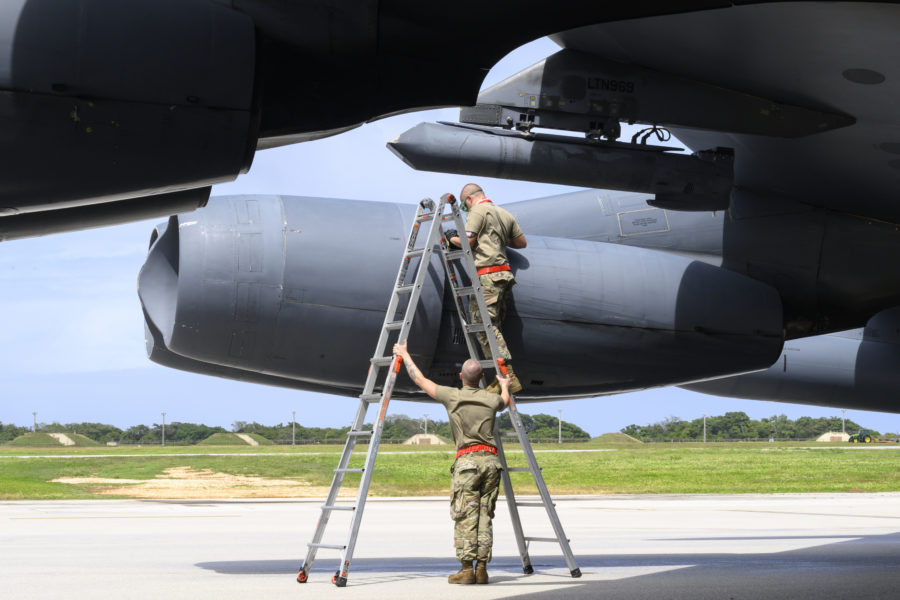The Air Force’s nuclear forces continue to struggle with supply chain problems, both those lingering from the pandemic and the inevitable challenges of operating equipment that’s decades old, Global Strike Command’s director of logistics and engineering said March 21.
Additive manufacturing could be the solution, noted Brig. Gen. Kenyon K. Bell, but bureaucracy has to be swept aside to make it work.
Speaking in a webinar presented by Defense One, Bell said “long lead times” in getting parts is his number one issue in maintaining USAF’s nuclear forces, which in the case of systems like the B-52 and Minuteman III intercontinental ballistic missile, go back decades.
The same issues that affected the nation in getting consumer goods during the height of the COVID pandemic—backlogs in shipping, shortages of materials—affected military sustainment, but to a greater degree, Bell said.
Exacerbating the problem now is getting resupply of parts and gear for platforms out of production for decades, he noted.
When there were 750 B-52s in service, an industrial base to supply parts and equipment wasn’t an issue, Bell said, because there were plenty of vendors who would compete for that business. But with only 76 Stratofortresses left, it’s hard to interest companies in making the investment needed to be a supplier.
“It’s a different business proposition,” he said, adding that AFGSC has to get “creative” without the luxury of simply retiring old systems like Minuteman in anticipation of the new Sentinel missile, because the old nuclear systems must be fully functional right up until the second of the handover to the new equipment.
One answer is to work with Air Force Materiel Command—and particularly with the Rapid Sustainment Office—to find other systems that need similar or common parts and making a bulk buy, which can attract industrial interest.
“If I only need three or four of an item … that might not be lucrative enough” to justify a business making a bid,” Bell said. “Remember … it is still a profit-driven business.” But with an order of “10 or 25, now someone is willing to come to the table and meet my national security need. So we have to figure out, creatively,” how to meet the government’s requirements while still having it “make sense for business return on investment, for the company to bring tooling and people to bear.”
But tooling up to make a new part requires lead times “not in days, but in years,” Bell said and the need is urgent.
In some cases, the need can even arise when a part that has never broken before finally snaps. AFGSC can do assessments, prescribe systems, figure out the technology and finalize designs. But at the end of the day, “we’ve never ordered this” before, Bell said. “Now what do you do?”
Moreover, “you’re not going to be able to wait. Sometimes you can cannibalize … another aircraft.” But in cases when that’s not possible, the service must “look at the technology that we have available to us.”
In such situations, additive manufacturing—or 3-D printing—shows great promise, Bell said, but it’s not as simple as just printing new parts.
“Additive manufacturing, 3-D printing, reverse engineering—all of those technologies are going to be key and critical to maintaining legacy or aged weapons systems,” he said.
“But there are lots of critical certifications that are required … what I have frequently talked to our team and our enterprise about, is, let’s not hide behind nuclear certification as a roadblock, but let’s work with and through the nuclear certification process to utilize some of these new technologies. Yes, it will be challenging, but it does not make it impossible to do,” he said.
The aerospace industry has only recently begun to move from 3-D printed parts that have similar strength and performance to original components in structural roles—think brackets and stiffeners—to those that can be used in “flight critical” functions, such as within engines. Nuclear certifications are that much more demanding, with zero tolerance for failure.
Chief of Staff Gen. Charles Q. Brown Jr. “has been very vocal” about breaking down bureaucracy, Bell said. “He’s been frustrated with the bureaucracy … so we have a significant advocate to make sure that we can get to where we need to be and get there fast.”
But the industrial base “doesn’t know whether or not we can make good on our promise that we’re going to go and buy this particular part, because we don’t know if we’ll have a budget to fund it,” Bell said. Particularly on legacy weapon systems, “it makes it even more challenging.” This problem “certainly hamstrings us quite a bit when it comes to” clearing bureaucracy, he noted.
What’s more, the issue is not going to go away, Bell said, noting that the B-52 will be in the inventory “through 2050 and beyond.”
